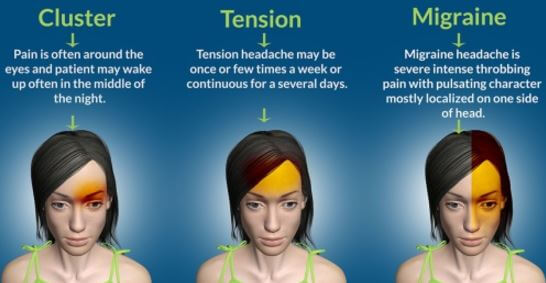Ocular Migraine
What is Ocular Migraine?
Ocular migraine is a confusing term. The most appropriate term would be a migraine that has vision disturbances. To understand the term fully, we must discuss migraine as a whole. Migraine is a common cause of headache. It is episodic in nature and has features such as sensitivity to light.

Describing migraine can be likened to a recurrent headache with different admixtures of neurologic dysfunction. Migraine has activators known as “triggers”.
We will need to make a focused discussion on the brain and the pathways associated with the development of migraine. The brain is one of the most complex organs as its processes are not readily evident to gross observations. But the mixture of neurotransmitters and chemicals will be critical to understanding how it develops and what is currently being done to correct it.

Image 2. The pathways involved in the development of migraine.
The brains of the “migraineur” are exquisitely sensitive to the environment in terms of stimuli and are unable to acclimatize easily. This is even more pronounced in females during the menstrual cycle.
“Triggers” include but not limited to light glare, loud sounds, stress, physical exertion, changes in pressure and temperature, alcohol and chemical stimulation such as nitrates. Life style adjustments can be made to ensure that the exposure to these “triggers” is limited and the occurrence of migraine lessened.
Causes & Pathogenesis
How does ocular migraine come about itself?
The pathogenesis of migraine can be traced to the dysfunction of the monoaminergic sensory control in the hypothalamus and brainstem. Activation of the trigeminal cells releases a cocktail of neuropeptides, particularly calcitonin gene-related peptide (CGRP) at the trigeminal peripheries and nucleus. CGRP antagonists have been successfully tested to treat acute migraine.

Pharmacologic studies have led to the involvement of serotonin, a prominent neurotransmitter and peptide in the development of migraines. About 60 years ago, the first “triptans” and “ditans” were developed to treat migraine. Specifically, they arrest neuro signaling of the nociceptive pathways of the trigeminal system.
There are currently investigations into drugs that can be used as prophylaxis against migraine. The neurotransmitter dopamine has also been implicated in the development of migraine. Dopamine receptor antagonists are effective therapeutic agents against migraine.
Symptoms & Diagnosis
A high index of suspicion is required to diagnosis migraine. A person must have a headache that lasts anywhere from 4-72 hours with no other discernible, underlying medical condition explaining the headache. There must be two of the following; Unilateral pain, throbbing pain, aggravation by movement and moderate to severe intensity of pain. May also include one of the following; nausea and vomiting with photophobia or phonophobia.
Of special focus, migraine aura or better known to us as ocular migraine is diagnosed if the patient complains of zigzagging lines or flashing lights across the visual fields with other neurologic symptoms. Patients usually may have headache diary to document the occurrence. Patients may also have to screen in order to rule out other kinds of migraine such as tension headache.

Image 3: An example of the visual field of an ocular migraine sufferer.
The main difference is that migraine aura has the aforementioned features while tension headache does not. Patients with acephalic migraine or a migraine with aura but no headache may have recurrent signs and symptoms. Vertigo or the spinning of the surroundings is heavily associated with migraine and about 1/3 of patients are diagnosed with migraine if they report this symptom.
Treatment
Once the diagnosis of ocular migraine is confirmed, it is important to assess the extent of the disability caused by the ocular migraine. Educating the patient about his condition goes a long way into understanding the cause and how best to avoid its triggers. Sometimes, we may have to watch out for women on estrogen therapy as this may be life-threatening, anything else, migraine is a benign condition.
Let’s first deal with the non-pharmacologic management of ocular migraines. One good way to reduce the impact of migraine is to adopt a healthy lifestyle. Eating plenty of fruits and vegetables, getting adequate amounts of sleep and getting enough exercise are good behavioral changes that one can do to increase the resistance to the debilitating effects of ocular migraine.
One may also engage in yoga, transcendental meditation or hypnosis. But at the very least, these interventions are just adjuncts to pharmacologic therapy. If these fail, then the need for pharmacologic intervention is indicated.
The drugs that can be used to treat migraine are non-steroidal, anti-inflammatory drugs, serotonin agonists and dopamine receptor antagonists. The mainstay of treatment is cautious use of drugs to relieve the migraine. For mild migraines, oral therapy will suffice but for severe ones the use of parenteral or intravenous agents will do better.
Despite the effectiveness of drugs, the therapy has to be customized to the sufferer. Indeed, there no “one-size fits all” therapeutic regimen and that the drugs used have to be balanced to provide rapid and effective relief with minimal side effects.
Some patients may be good candidates for prophylactic therapy to prevent migraine from even occurring. These may be associated with one or more side effects and standard practice requires patients to start with a low-dose regimen until maximum clinical benefit can be achieved.
Drugs included in prophylactic therapy are timolol, valproic acid and topimarate. A word of caution however as these therapies may only be effective in about 50-70% of patients. Taking these drugs may also alter the natural course of migraine, greatly influencing the history to assist in treating the condition.
Conclusion
Ocular migraine is no doubt one enfeebling condition. Steps must be taken by the sufferer to avoid the triggers which cause the ocular migraine. This particular migraine is associated with visual disturbances such zigzag lines and flashing spots.
Although drugs are present to treat acute ocular migraine, patients education and non-pharmacologic treatment will go a long way into helping the patient achieve a migraine-free life.
